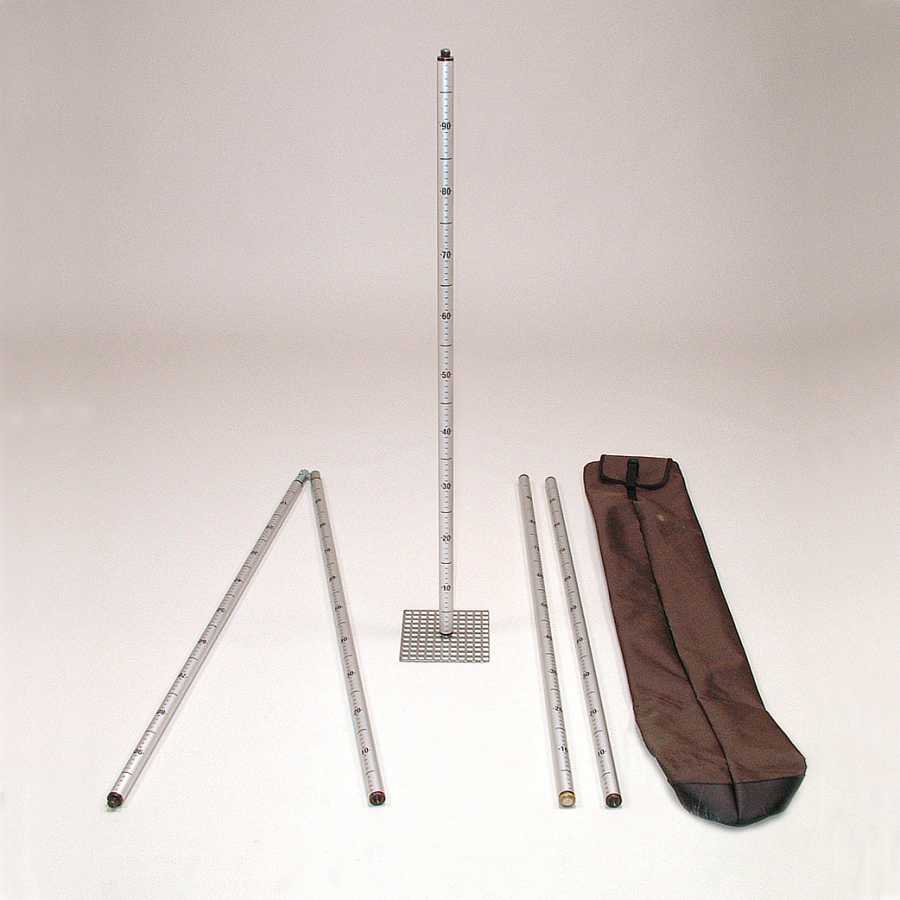Dipstick/sounding rod
With this manual technique, the depth of the sediment can be measured. The dipstick has a foot. This is lowered vertically to the bottom of the water. Then the height of the water column above the foot is measured.
A dipstick is a dipstick on a fishing rod. The difference between a stick and a fishing rod lies in the approach to the water bottom from the side (rod) or from a boat (stick). If the foot is exchanged for a point, the thickness of the 'soft' (non-consolidated) sediment or silt layer can also be determined.
| General information | |||
| Name | Dipstick / sounding rod | ||
| Unit of measure and parameter | Height of water column in centimeters or thickness of the sludge layer | ||
| Nature technique | Physical | ||
| Place of application | in situ | ||
| Detection Mode | Drilling / stabbing or measurement at ground level/water bottom | ||
| Applicable in separate layers | new | ||
| Land soil/water bottom | water bottom | ||
| Step in the data collection chain |
| ||
| Moment of availability results | Measurement results are available in the field | ||
| Technology development phase | Applied routinely | ||
| Method of purchasing | as service or as a device | ||
| General description of the implementation method | The dipstick with foot is sunk down to the sludge. There is a light version that is placed with a fishing rod or a heavier version that is carefully placed from a boat or into the water. The height of the water column can then be read on the basis of a measurement on the stick. This means that the depth at which the water bed is located is known on site. With a sounding rod the same can be done from the side up to a maximum waterway width of 6 m. If foot is exchanged for a point, the thickness of sediment or silt layers can also be determined. | ||
| Working principle | The height of the water column can be measured by means of a graduation on the stick. A fishing rod provides a good vertical measurement from the shore. | ||
| Point / line measurement / volume measurement | Point measurement | ||
Technical specifications (including accuracy) | Dipstick is made of aluminum; periodic calibration prevents measurement errors. Accuracy: ± 1 to 2 centimeters (depending on the wave action) | ||
| Typical depth range | Dipstick maximum 5 meters Leveling rod maximum 2 meters. | ||
| Time properties | A single measurement can be performed in a short time. | ||
| Measuring rate | From 1 minute per measurement | ||
| Presentation results | Observation is directly readable on the dipstick; several measurements form a cross section. | ||
| Cost | Vary very strongly per provider and conditions in the field: from € 20 to € 150 per measurement | ||
User information | |||
| availabilty | large number of providers | ||
| Is technology often used? | Very organized | ||
| Research phase in which technology can be applied |
| ||
| Verification measurements / calibration measurements | are often used | ||
| Frequently used application in practice | Gauging in and out of smaller waterways and of sediment or sludge layer thickness | ||
| Suitability | Suitable for manually sounding waterways that are not too large. | ||
| Practical experiences in the Netherlands | It is used very regularly, mainly by water boards or consultancy firms throughout the Netherlands. Experience shows that the accuracy strongly depends on the circumstances and the sounder. Manual gauging usually gives a good idea of the thickness of the sludge layer. | ||
| “Dos“ | Measuring level with a higher measurement density at the slopes | ||
| “Don'ts” | Use as little pressure as possible when probing to press the foot into the sludge layer. | ||
References
Contents

